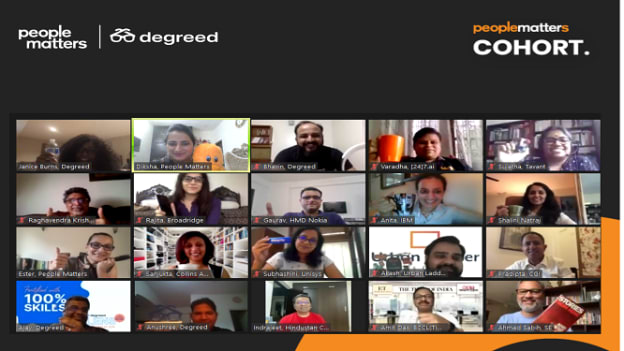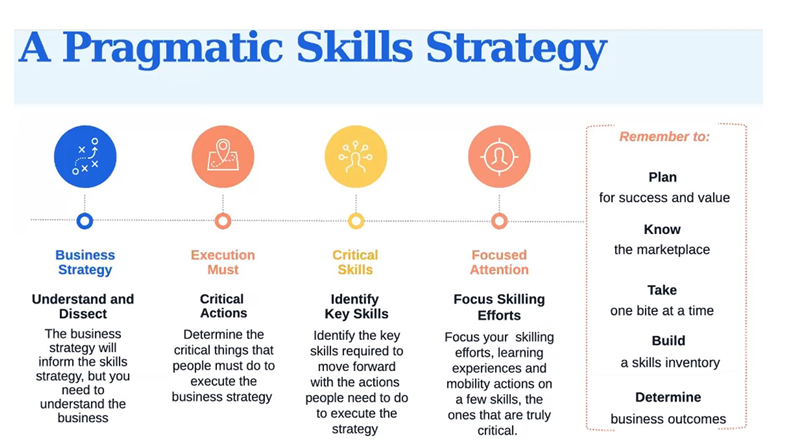Navigating crisis through the right skills and learning opportunities: Degreed & People Matters Cohort

Janice Robinson Burns is Chief Career Experience Officer at Degreed. Prior to this, Janice worked as Chief Learning Officer at MasterCard for over 28 years. Janice lives and works by a solid set of values and motivations and is passionate about driving skills enablement, creating knowledge communities and facilitating learning opportunities in order to give people a chance to pursue more meaningful and satisfying careers. As part of the People Matters in association with Degreed Cohort, we met with Janice to discuss changing L&D and skilling priorities, many of which have been accelerated by the present situation, as well as what leaders themselves will need to face this crisis, all while implementing a skills-based strategy to find answers in these volatile times.
Four ways of thinking about yourself
This is an exciting time for HR professionals, Janice says, “We have real influence. We can have a greater impact than we ever have had before by thinking of ourselves in four ways.” These are:
- Business accelerators. “If you can bring an informed strategy to a business that ties into their execution plans, you can accelerate how they achieve outcomes.”
- Talent multipliers. “If you have people who have the possibility and a profile that has a variety of skills that can be deployed in different areas of the organisation, you’re multiplying the value of the talent within the organisation.”
- Experience managers. “As you’re thinking about the win-win for both the business and the employee, you have to think about the experience of the employee. What’s in it for them? What’s going to motivate them?”
- Culture Driver. “A sustainable skill strategy also has to fit into a culture that’s also a learning culture,” says Janice.
Skills have never been more important than they are today

“As much as I’m a dreamer, I’m also pragmatic,” Janice says. “If you want to get momentum with the business and with the employees, you have to get quick wins so that they begin to trust you and have confidence in you. That allows you to do bigger things over time.”
With that in mind, Janice shared with us her pragmatic plan for building and implementing a pragmatic skills strategy:
- Start with your business strategy: Glean skill needs. “Scan the marketplace,” Janice says. “Look inside the organisation from a business strategy perspective and outside to get a more holistic sense of where you want to go.”
- Execution must: Rather than asking executive leaders what skills they think are important for the business, instead ask them “given your strategy, what are the most important things people actually have to do to execute the strategy?”
- Identify key skills: “As you’re thinking about this skill strategy, it’s important to remember that you plan for success and value that you’re going to provide to the organisation,” Janice says. “That you know not only your business, but you know the marketplace and where you sit within that marketplace. That you take one bite at a time and not try to take on an entire competency model approach to a skill strategy.”
- Establish business outcomes: Another key element of strategy is to establish early-on what success will look like and do so using the language of business outcomes to discuss this with senior leaders. “It’s not just about a learning exercise or a skill-building exercise, it’s about how you can help to accelerate the business and accelerate execution by focusing efforts on things that matter most to them in terms of business outcomes,” Janice says.
- Focus your attention: Establish the people who need these skills and prioritize key groups. Make an inventory of the skills that are needed versus the skills they already have. This will allow you to see what skill approach to take i.e. outskilling, reskilling, upskilling, redeploy skills or buy skills.
- Bucket skills to determine demand: “Bucketing the skills into four major categories really helps,” Janice says, in approaching the development of a skills strategy. For example, skills could be divided into professional, functional, hot and leadership skills, many of which would be required by many different groups, allowing customizable programs to be tweaked accordingly. “In building these programs, we always worked with the leadership team of that business to make sure that the skills we were teaching related to the jobs they needed to do.”
- Make a skills inventory: Where are the gaps? What skills do you already have in place? This will allow you to understand your skill profile, determine your supply, quantify your demand, understand proficiency levels and ultimately execute your skills strategy.
- Plan for success by ensuring you can deliver value to the business: “When you’re thinking about your skill strategy,” Janice says. “it’s important not only for you to plan for success but to remember that skills are only as important as the people who actually hold the skills: your employees.”
Ultimately, this comes down to motivation, engagement and purpose in skill strategy. “You cannot unlock skills unless your employees decide that they want to share those skills with a company.”
Dealing with uncertainty
On the question of uncertainty, Sanjukta Sarkar, Country Director - Human Resources at Collins Aerospace, asked how, now that we’re in the mode of “just get the job done,” how can we plan ahead in such a dynamic and constantly changing situation?
Janice said that, “you can usually spot trends and make some educated guesses about skills and needs. Some things are going to always be necessary.” During her time at MasterCard, for example, being able to develop digital payment programs was never going to change. “You have to look at your business and say: what are the things that are so basic they’re never going to change, and do you have that supply of skills?” Then look at external and internal trends and take educated guesses.
Focusing on what is unlikely to change about business needs will help to negotiate this inevitable uncertainty.
Also look at transferable skills, Janice says, the soft skills that have grown in demand since COVID. Help people build skills that they’re passionate about that are also transferable. “When you allow people to be honest about what they really want to do with their careers and you help them map out what they want to do with their careers, they self-select if they want to go in or want to go out.” Freedom of choice builds motivation and engagement, particularly over our own careers.
How are we becoming business accelerators?
Opening the discussion up, we gained so many great insights:
Amit Das, Director - Human Resources & CHRO, Bennett Coleman Co Ltd (Times of India group), said their company has dealt with this situation by “building multiple business scenarios that have helped us to look at the future challenges and implications for each of these scenarios.”
Pradipta Banerjee, Vice President - Global Human Resources Centers of Expertise at CGI added that, “clients also want us to be successful.” Pradipta said, “Team members at CGI are becoming business accelerators through client-centricity. At CGI, they have “a clear line of sight between the three paradigms” of the client strategy and their road map, CGI’s strategy and the learning strategy. They reiterate this every three months. “Given the fact that these days nobody knows what the right thing is, I think it’s important for the client and the service operator to come together and work together far more closely and therefore be able to collectively drive the learning strategy that directly impacts the client’s business.”
Ajay Sridharan, VP - South East Asia at Degreed expressed that today, most of the CLOs would love to see themselves as contributing to the business and not just acting or reacting to what is happening. So, they are now interacting with a lot of business units to understand the business deeper and also understand what kinds of skills are needed to accelerate the business outcomes. “Apart from that, we have seen that organizations that have been nimble, agile and are able to quickly surf through the unknown, and the CLOs that are able to adapt to these changing needs are the ones which are really successful today.”
Anita Sinai Guha, CIO Talent Advisor, IBM made an excellent point regarding the culture of learning at an organisation. While IBM has been successfully continuing with learning and skilling initiatives, Anita is wary of focusing too much on one outcome and becoming bluntly transactional about ROI. “Part of a culture of learning is to allow for that serendipity of people learning something new that is not directly related to your area, but because you know it you can use it when something unexpected comes up.”
In response to this, Janice said that she in fact doesn’t believe in ROI calculations. “Many learning people try to create ROI equations to make a point to prove that what they’re doing is valuable, but if you really talk to a CFO they don’t buy those calculations.” A more effective approach? Look at business outcomes and show how your strategies are leading to these business outcomes.
Further to Janice’s point on talent multipliers, interesting ideas were shared on how leaders are approaching this:
Ahmad Sabih Kidwai, Director - HR, Talent Management, OD & Learning Greater India of Schneider Electric shared: “We call it Open Talent Market. It’s an AI enabled tool in which people can put in interesting projects that are very different from their day jobs.” This tool not only picks up on skills, but on interests too, creating a more personalized user experience. Sanjukta Sarkar added that Collins Aerospace has something similar, and that talent mobility has actually increased under COVID. “Surprisingly it’s feasible right now. People are starting new roles remotely. It hasn’t stopped any movement at all,” she said.
Bikram Jeet, Head of Business HR at BlackBuck, highlighted how COVID has led to leaders being more open to sourcing and taking talent from people “not geographically located in the same place.” We have the freedom now to recruit skilled people from a diverse array of physical locations, creating new possibilities for leaders.
Shalini Nataraj, Global Head HR, fleet and Strategic brands at Maersk, gave insight into how the company is being more deliberate in how they manage internal talent. “We’ve looked at roles and regions as a group, identified the different positions where they’re open to having talent from a different entity,” and planned succession plans well in advance to avoid a “scramble” to fill roles.
Indrajeet Sengupta, Executive Director and Chief Human Resources Officer at Hindustan Coca-Cola Beverages, shared how the company is rethinking talent strategy. To motivate and engender a more mobility-friendly mindset, Coca-Cola have begun giving short term assignments to talent working across geographies, helping teams in other countries. This allows them to “go beyond skill and start taking actions in actually developing people and benefiting them directly with the business strategy.
From a talent mobility perspective, we have a lot more freedom now because, ironically, COVID has somewhat proven we don’t really have to go anywhere! As Varadharaju Janardhanan, Vice President & Head of HR at [24]7.ai points out, the pandemic has “completely changed the business landscape.”
Closing Remarks
When it comes to leaders reskilling their people to work virtually, there’s so much to consider. In her closing remarks, Janice broke it down for us into four key areas:
Checking in
“It’s not about checking up to see if someone is doing what they’re supposed to do, but checking in to make sure people are ok,” says Janice. “If leaders use the technology correctly you actually can create better and more intimate relationships with your team because you have access to everyone.” As Janice points out, this isn’t going to be the last crisis, so building skills that will help leaders manage crisis-like situations will continue to be crucial.
Technology
While tech can help build a sense of inclusion, Janice warns against buying loads of tech and thinking it will be the solution to all problems. “The technology must be an enabler of your strategy,” Janice says. “The technology must be human-centric. Technology by itself is never going to be the answer.”
Values
In discussing the importance of values, particularly now organisations are talking more about care, employee-centricity and the importance of learning, Janice was clear. “Values only count when they’re tested. That’s when you have to make real decisions about whether you’re going to live those values or not.” Learning and skills strategies absolutely must include those value concepts.
Designing Careers
As someone who has had many careers within an organisation herself, Janice closed by saying that “everyone has the ability to change and grow in their career. The question is ‘do they have the desire to do it? Do they have access to the skills and resources to do it?” Janice followed her passions and changed company after over 20 years at one organisation. She really had to hit the ground running and utilize skills she’d not had to employ as much previously. “You learn the most when you’re put in the fire and have to do it,” Janice says. “If you can provide the support for people - putting them in situations where they can learn the skills while doing - it’s the most effective way to build the skill. You just have to provide the support.”
What better time than now to learn by doing and truly put ourselves to the test! The possibilities really are endless!
Thank you so much Janice for taking the time to talk to us about your story and your learning. There were so many ‘Aha’ moments and crucial takeaways. This session will no doubt resonate for all of us as we forge ahead in developing our learning and skilling strategies.














